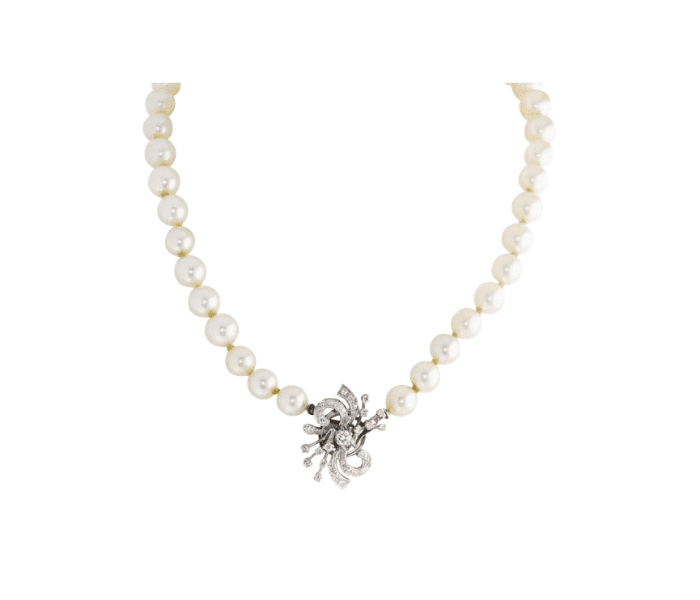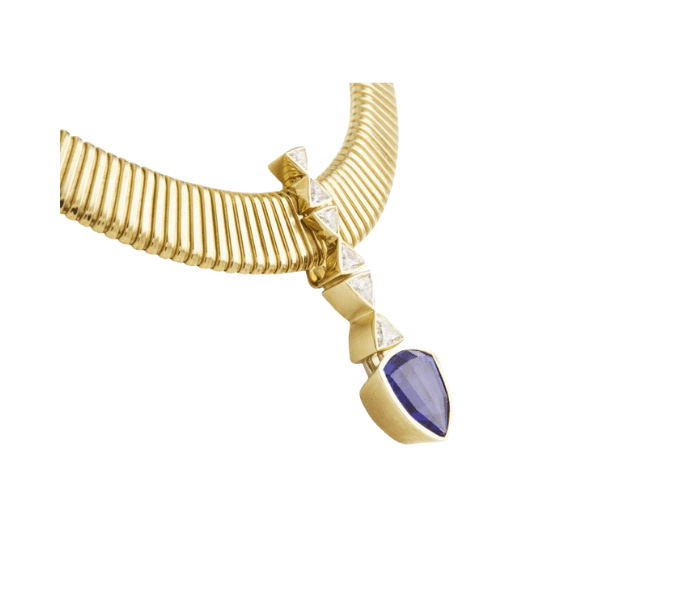
Last spring, we discussed how to tell if a diamond is real or fake. We talked about some DIY tests for diamonds—the fog test, the reading test, the water test, and more—which are fun to try and can at least give you an idea of what you have, but they’re not a replacement for a proper evaluation.
Unfortunately, with the exception of pearls, DIY testing is not really an option to tell you if a colored gemstone is real or faux. There are tests that gemologists will perform to make that determination, but they’re not ones that consumers typically can (or should) try at home. Don’t ever try to scratch or hammer a gemstone to see how it reacts! If you have a colored gemstone and you’re anxious to know if it’s the real thing, take it to a reputable jeweler.
For pearls, your own teeth can identify real from faux. No, you’re not going to bite into them! Gently slide the pearls across the front surface of your teeth and see how they feel. If they feel a little rough, they’re most likely real. This sensation owes to the microscopic layering of the nacre, which under magnification shows a shingled type surface similar to that of a human hair under magnification. By contrast, faux pearls don’t have that cuticle and will feel very smooth as you glide them across your teeth.
But there’s still some information about colored gems that is good to know.

Is it possible for someone to manufacture a faux pearl with a layered surface that feels real in the tooth test? Maybe, but there’s not much financial incentive to do so and thus far in the jewelry industry we haven’t heard of it being an issue. Still, like anything else, if you have a piece of pearl jewelry that you believe is very valuable, take it to a jewelry professional to have it evaluated because there are different qualities and varieties of pearls, and that will greatly impact the value of your piece.
Now let’s talk about colored gemstones. First, understand the terminology surrounding gemstones: natural, treated, genuine, synthetic, and simulated. Also understand the different kinds of appearances a stone can have: transparent, translucent, and opaque.

A natural gemstone is a gift of nature, formed deep in the earth billions of years ago and brought to the surface (or close enough to the surface to be mined) through volcanic eruptions, water erosion, tectonic plate shifts, or other natural phenomena. A natural gemstone is untreated beyond simple cutting and polishing.
You may have seen or owned jewelry with gems labeled genuine. This is not an official industry term. GIA (Gemological Institute of America) is the industry’s leading gem laboratory and research center. Its official terminology is “natural-treated.” This means the gemstone is a natural gemstone that’s been treated in some way to enhance its appearance. It was formed in the earth but is perhaps not as desirable of color as some other specimens of that mineral. By heating it (such as is done to rubies, sapphires, quartzes, and other minerals) it becomes a deeper and more desirable color, enhancing both its beauty and its value. For some gem materials, heating changes its color altogether: for instance, Tanzanite is a dull brown when it comes out of the earth, but heating it to high temperatures turns it into the deep, velvety, purplish-blue we all associate with the gem.
You can’t boost the value of your jewelry by popping it in the oven at home. The heat required to make a difference is in the thousands of degrees, not hundreds. And if you did put your own jewelry in the oven, some of the more fragile gem species (like emeralds and opals) might even get damaged, so if you were thinking about doing this (even for a nanosecond) don’t.
Heat is the most common means of treating a colored gem to enhance its color, but it’s not the only treatment. Emeralds, for instance, can’t be heated. They are often dipped in a light clear oil to enhance their appearance and fill the many microscopic cracks that most emeralds have. This is normal and fully acceptable. Dipping them into a green-colored oil to deepen their color is not acceptable unless it’s disclosed that they have been color-enhanced.


Another common form of treatment is irradiation, such as is done with blue topaz to turn them into the beautiful blue color. Like heat treatment, radiation is stable—meaning the stones will not revert to their original appearance over time—and no, the stones are not radioactive when you buy them (any more than you are radioactive after an X-ray.)

The value of colored gemstones is impacted by their treatment. If the stone is relatively unattractive in its natural state, it won’t be worth much, so the treatment boosts its value significantly. But a treated gem won’t have as much value as it would have if its appearance had occurred naturally without treatment. That’s not to say that the stone isn’t valuable—a large beautiful colored gem, even treated, isn’t going to be cheap—but as noted, it won’t cost as much as a comparable untreated specimen, which is rarer. And, as we also noted, some gem species like Tanzanite simply wouldn’t be valuable at all without the treatment.
The U.S. Federal Trade Commission requires that all treated gemstones carry a disclosure of the treatment.
A synthetic gemstone is still a “real” gem in that it is chemically, optically, and physically nearly identical to its earthly cousins. It’s just created in a machine in a lab instead of in the earth, and it takes a matter of weeks, not millennia, for the crystal structure to form. But everything else is the same: its hardness, its refractive index, and so on, will be the same as the natural specimen.
As an analogy, compare a lab-grown stone to certain pharmaceuticals such as synthetic hormones, insulin, or melatonin. All are substances the human body creates naturally on its own, but they’ve been broken down to their chemical compounds and recreated in a laboratory. They perform the same function as the natural substance but they were created in a lab, not in the body.
Synthetic gemstones have been around for a long time: the first rubies were grown well more than a century ago! They are detectable by jewelry professionals and gem labs with proper equipment, though some of the best quality synthetics can be challenging for a typical jeweler to detect with just a microscope in store. Those should be sent to a gemological laboratory for evaluation if there is any question.
By law, synthetic gems also are required to carry a disclosure that they’re synthetic because their value is significantly less than a comparable natural or even treated stone. Simply put, although beautiful, they’re not that rare. They might not be cheap—it costs quite a bit to create them, especially the higher qualities—but they won’t be as costly as the natural version of the same thing.
A gem simulant, or imitation gem, is just that: something that looks like the real thing but is a different material altogether, such as glass, resin, cubic zirconia, and more. Here, think about good fake fur: you might not be able to tell the difference without touching it but it’s a different fiber, not an animal skin. By law, gem simulants have to be called imitation or simulant, they can’t be called something they’re not.
Like diamonds, colored gemstones tend to have microscopic imperfections, called inclusions, in them. You might think the presence of inclusions is a good way to tell natural from synthetic stones, but in fact, synthetic stones and natural stones both have inclusions. Synthetic inclusions may look slightly different from those occurring incomparable natural stones, but only a professional can tell the difference. Even simulants can have gas bubble inclusions, depending on what they’re made from.
Some stones are actually two or more materials glued together. This is called an “assembled” stone. Look at it closely: a telltale sign is a ring around it. Or you might observe differences in color or luster between the different materials.
A piece of jewelry with an assembled stone can be valuable, depending on its creation. For instance, some designers, such as the renowned English jeweler Stephen Webster, use the technique as a design element. Webster’s Crystal Haze collection incorporates a slice of a vividly colored gem material on the bottom with a meticulously faceted clear quartz over it, so that the entire effect is one of glowing color.

The artistic effect, coupled with the jeweler’s high-end reputation, makes the piece valuable. (Think of trying to price a Picasso by the value of canvas and paint—not done!)
Finally, know that colored gemstones can be transparent, translucent, or opaque.
©2011-2025 Worthy, Inc. All rights reserved.
Worthy, Inc. operates from 25 West 45th St., 2nd Floor, New York, NY 10036